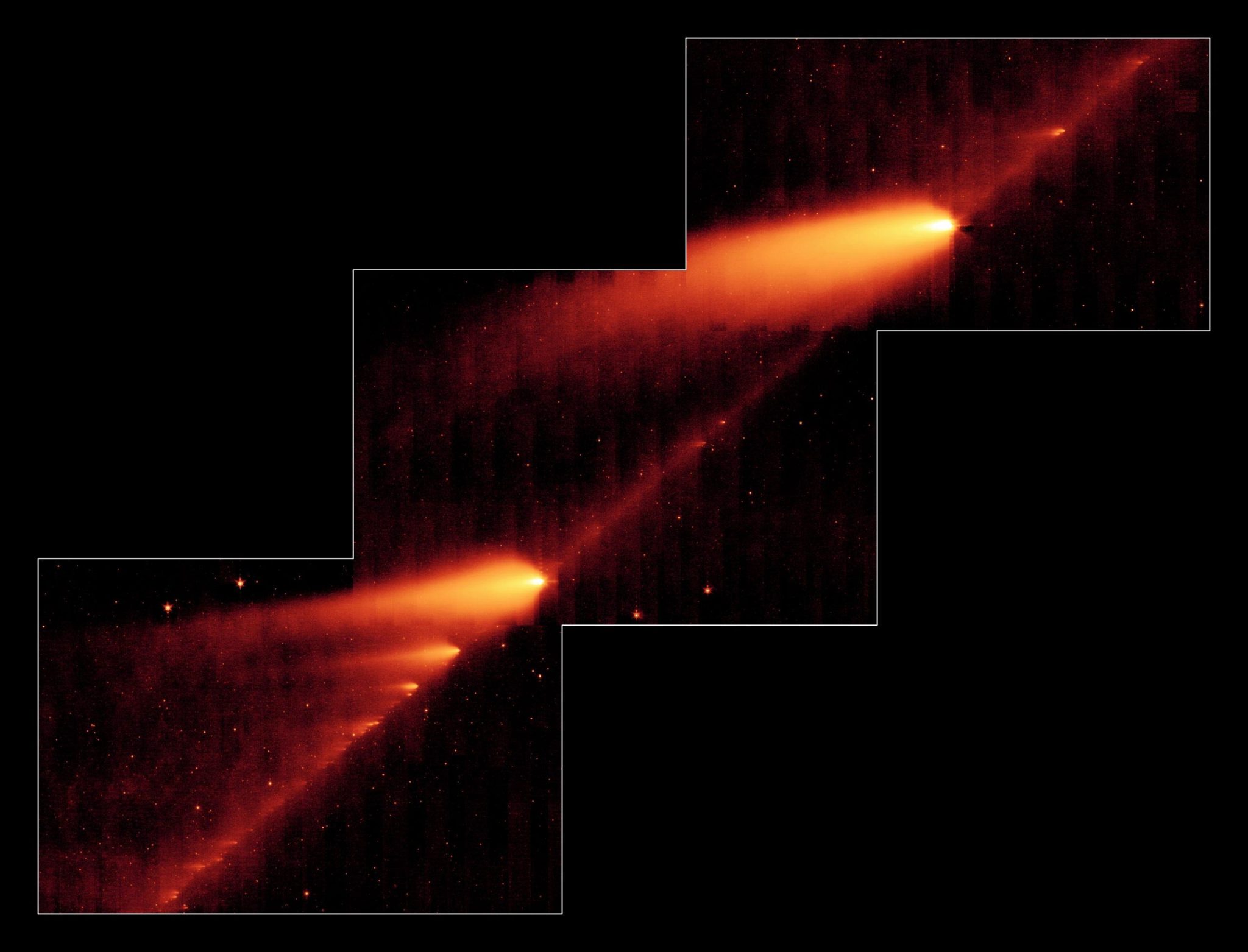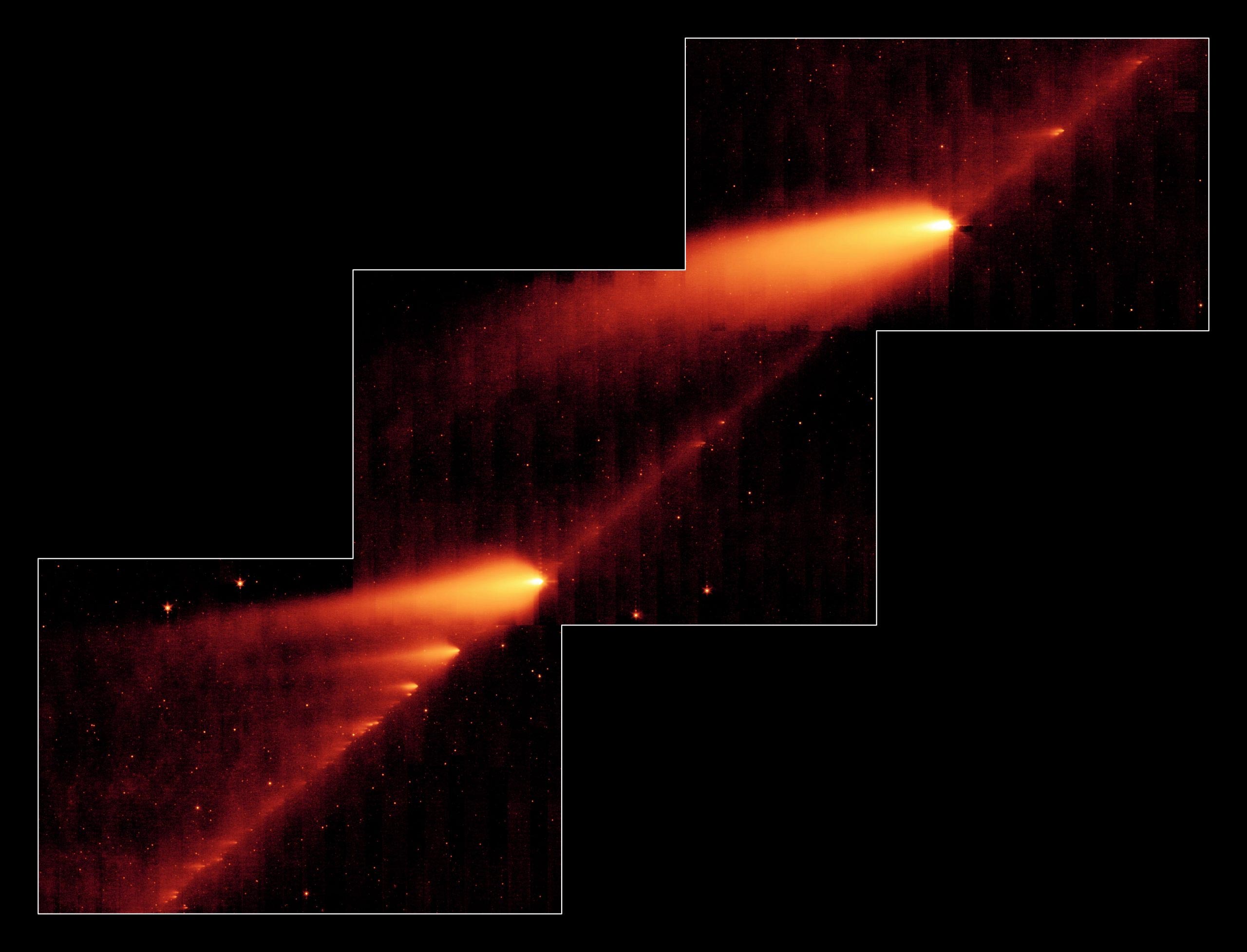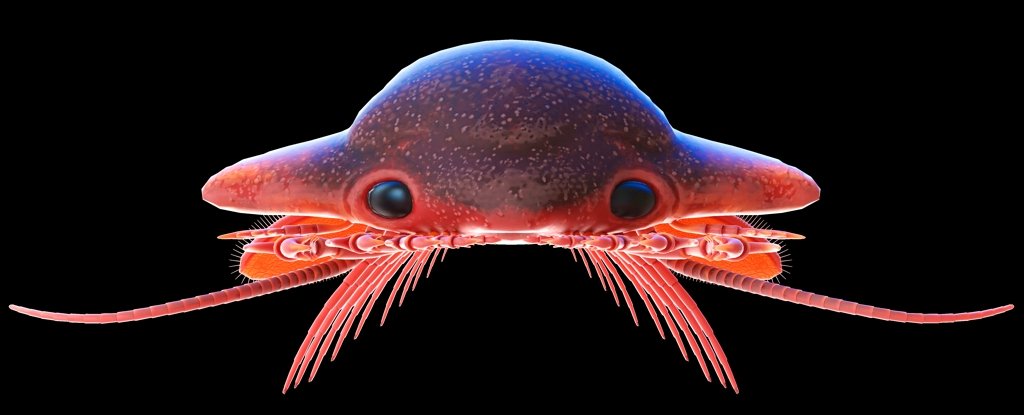
تظهر هذه الصورة بالأشعة تحت الحمراء من تلسكوب سبيتزر الفضائي التابع لناسا مذنبًا محطمًا 73P / Schwassman-Wachmann 3 وهو يلامس أثرًا من الحطام المتخلف عن رحلاته المتعددة حول الشمس. الأجسام الشبيهة باللهب هي شظايا المذنب وذيولها ، في حين أن مسار المذنب المغبر هو الخط الذي يربط الشظايا. الائتمان: ناسا
يشعر علماء الفلك بالحماسة إزاء احتمال تساقط نيزك آخر في 30-31 مايو ، وهو دش Herculid tau ، والذي من المتوقع أن يبلغ ذروته في ليلة 30 مايو وفي وقت مبكر من صباح يوم 31 مايو.
في عام 1930 ، اكتشف المراقبون الألمان أرنولد شفاسمان وأرنو آرثر واشمان مذنبًا يعرف باسم 73P / Schwassmann-Wachmann ، أو “SW3” ، والذي يدور حول الشمس كل 5.4 سنوات. نظرًا لكونه خافتًا للغاية ، لم يُشاهد SW3 مرة أخرى حتى أواخر السبعينيات ، حيث بدا طبيعيًا إلى حد ما حتى عام 1995 عندما أدرك علماء الفلك أن المذنب أصبح أكثر سطوعًا بنحو 600 مرة وانتقل من بقعة باهتة إلى أن تكون مرئية للعين المجردة أثناء مروره. بعد إجراء مزيد من التحقيقات ، أدرك علماء الفلك أن SW3 قد اقتحم عدة قطع ، مما أدى إلى تناثر الحطام في مساره المداري. عندما مرت عبر طريقنا مرة أخرى في عام 2006 ، كانت تتكون من حوالي 70 قطعة وهي تتفتت منذ ذلك الحين.
إذا وصل إلينا هذا العام ، فإن حطام SW3 سيضرب الغلاف الجوي للأرض ببطء شديد ، حيث يسافر بسرعة 10 أميال في الثانية فقط – مما يعني أن النيازك أخف بكثير من تلك التي تنتمي إلى eta aquarids. لكن علماء الفلك في أمريكا الشمالية أخذوا ملاحظة خاصة هذا العام لأن إشعاع Herculid tau سيكون عالياً في سماء الليل في ساعة الذروة المتوقعة. والأفضل من ذلك ، أن القمر جديد ، لذا لن يكون هناك أي ضوء قمر ليغسل النيازك الباهتة.
“سيكون حدث كل شيء أو لا شيء. إذا كان الحطام من SW3 يسافر أكثر من 220 ميلاً في الساعة عندما انفصل عن المذنب ، فيمكننا رؤية زخة نيزكية لطيفة. قال بيل كوك ، الذي يوجه[{” attribute=””>NASA’s Meteoroid Environment Office at NASA’s Marshall Space Flight Center in Huntsville, Alabama.
All the excitement from astronomers and the public has sparked a lot of information about the tau Herculids. Some has been accurate, and some has not.
We get excited about meteor showers, too! But sometimes events like this don’t live up to expectations – it happened with the 2019 Alpha Monocerotid shower, for example. And some astronomers predict a dazzling display of tau Herculids could be “hit or miss.”
So, we’re encouraging eager skywatchers to channel their inner scientists, and look beyond the headlines. Here are the facts:
- On the night of May 30 into the early morning of May 31, Earth will pass through the debris trails of a broken comet called 73P/Schwassmann-Wachmann, or SW3.
- The comet, which broke into large fragments back in 1995, won’t reach this point in its orbit until August.
- If the fragments from were ejected with speeds greater than twice the normal speeds—fast enough to reach Earth—we might get a meteor shower.
- Spitzer observations published in 2009 indicate that at least some fragments are moving fast enough. This is one reason why astronomers are excited.
- If a meteor shower does occur, the tau Herculids move slowly by meteor standards – they will be faint.
Observers in North America under clear, dark skies have the best chance of seeing a tau Herculid shower. The peak time to watch is around 1 a.m. on the East Coast or 10 p.m. on the West Coast.
We can’t be certain what we’ll see. We can only hope it’s spectacular.

“هواة الإنترنت المتواضعين بشكل يثير الغضب. مثيري الشغب فخور. عاشق الويب. رجل أعمال. محامي الموسيقى الحائز على جوائز.”





